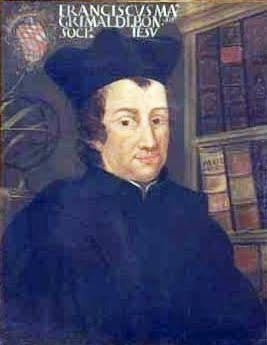Philosophy


Francesco Maria Grimaldi, an Italian Jesuit, was born on this date in 1618.
"In the late 1640s, he produced a large and detailed map of the moon, based on his own observations. His fellow Jesuit and Bolognese, Giambattista Riccioli, then invented a naming system for the various craters and seas, and published the map in his Almagestum Novum of 1651. The map is justly famous, because Riccioli's lunar nomenclature--one of several then available--turned out to be the one we still use. So the Sea of Tranquility first appears on Grimaldi's map, as do the craters Tycho, Plato, and Copernicus."--Bill Ashworth [Linda Hall Library Newsletter].
- Riccioli...not A Cough Drop But An Astronomer
A paper on Giovanni Battista Riccioli... What can physics students learn about science from those scientists who got the answers wrong? Your students probably have encountered little science history. What they have encountered probably has portrayed...
- Giovanni Battista Riccioli And Jupiter's Cloud Belts
"The recent disappearance of one of Jupiter‟s cloud belts...has attracted significant attention from the scientific media (Phillips 2010). While this recent disappearance of a cloud belt is dramatic, changes in the clouds of Jupiter occur from time...
- “genesis Rock”
Almost 40 years ago this day [July 30th, 19171] Apollo 15 landed on the Moon. And one of the items brought back to Earth was the so-called “Genesis Rock” which after analysis was dated to be 4.5 billion years old making it almost as old as the solar...
- Claude Mellan's Moon Engravings [1637]
Claude Mellan and Pierre Gassendi Three maps of the Moon 1637 These three maps of the Moon by the celebrated engraver Mellan, whose work was commissioned by Pierre Gassendi, show three different phases of the Earth's satellite. Claude Mellan...
- Francesco Bianchini And Venus
[Click to enlarge to read.] Francesco Bianchini, an Italian astronomer, died today 1729 and best known for his study of Venus. In 1728 he published Hesperi et Phosphori nova phaenomena sive Observationes circa planetam Veneris [New Observations concerning...
Philosophy
Francesco Maria Grimaldi...Giambattista Riccioli's "Almagestum Novum"--the Moon


Francesco Maria Grimaldi, an Italian Jesuit, was born on this date in 1618.
"In the late 1640s, he produced a large and detailed map of the moon, based on his own observations. His fellow Jesuit and Bolognese, Giambattista Riccioli, then invented a naming system for the various craters and seas, and published the map in his Almagestum Novum of 1651. The map is justly famous, because Riccioli's lunar nomenclature--one of several then available--turned out to be the one we still use. So the Sea of Tranquility first appears on Grimaldi's map, as do the craters Tycho, Plato, and Copernicus."--Bill Ashworth [Linda Hall Library Newsletter].
- Riccioli...not A Cough Drop But An Astronomer
A paper on Giovanni Battista Riccioli... What can physics students learn about science from those scientists who got the answers wrong? Your students probably have encountered little science history. What they have encountered probably has portrayed...
- Giovanni Battista Riccioli And Jupiter's Cloud Belts
"The recent disappearance of one of Jupiter‟s cloud belts...has attracted significant attention from the scientific media (Phillips 2010). While this recent disappearance of a cloud belt is dramatic, changes in the clouds of Jupiter occur from time...
- “genesis Rock”
Almost 40 years ago this day [July 30th, 19171] Apollo 15 landed on the Moon. And one of the items brought back to Earth was the so-called “Genesis Rock” which after analysis was dated to be 4.5 billion years old making it almost as old as the solar...
- Claude Mellan's Moon Engravings [1637]
Claude Mellan and Pierre Gassendi Three maps of the Moon 1637 These three maps of the Moon by the celebrated engraver Mellan, whose work was commissioned by Pierre Gassendi, show three different phases of the Earth's satellite. Claude Mellan...
- Francesco Bianchini And Venus
[Click to enlarge to read.] Francesco Bianchini, an Italian astronomer, died today 1729 and best known for his study of Venus. In 1728 he published Hesperi et Phosphori nova phaenomena sive Observationes circa planetam Veneris [New Observations concerning...
